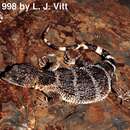en
names in breadcrumbs


Xenosaurus is a genus of lizards. Xenosaurus is the only extant genus in the family Xenosauridae with 14 species currently recognized.[2] Also known as the Middle American knob-scaled lizards found in southwestern Tamaulipas and eastern Guerrero on the Atlantic and Pacific versants of Mexico, respectively, south and east to Alta Verapaz, Guatemala.[3] They can be found between 300 m and 2360 m of elevation in a wide variety of habitats ranging from xerophytic tropical scrub to cloud forest to tropical rain forest.[3] Where they occupy moderately diverse places, including crevices and holes in limestone, spaces under volcanic boulders, crevices in volcanic rocks, karst limestone, limestone terrain, and hollow logs in dry areas where trees are sparse.[3] A flattened body shape and a crevice-dwelling ecology generally characterize species in the group. In part because of their habitat specialization, all of the known species and subspecies are allopatric, and several have small geographic distributions.[3] Dorsal scales are heteromorphic, not imbrication, and some are conical or developed into enlarged tubercles separated by small granular scales. Ventral scales are flat, quadrate, and arranged in transverse rows. Head scales are generally small, tuberculate, and sometimes conical or rugose, but may be enlarged along the rostra and temporal ridges. Supraoculars also are enlarged, flattened, and in a single longitudinal row. The skin of the neck is loose and expanded, producing at least two angular fold.[4] These lizards are known to feed on a variety of crawling and flying insects. This genus mostly eats orthopterans, coleopterans (beetles), dipterans, and myriapods.[5]
The following 14 species are recognized as being valid.[2][6]
Nota bene: A binomial authority in parentheses indicates that the species was originally described in a genus other than Xenosaurus.
Xenosaurus is a genus of lizards. Xenosaurus is the only extant genus in the family Xenosauridae with 14 species currently recognized. Also known as the Middle American knob-scaled lizards found in southwestern Tamaulipas and eastern Guerrero on the Atlantic and Pacific versants of Mexico, respectively, south and east to Alta Verapaz, Guatemala. They can be found between 300 m and 2360 m of elevation in a wide variety of habitats ranging from xerophytic tropical scrub to cloud forest to tropical rain forest. Where they occupy moderately diverse places, including crevices and holes in limestone, spaces under volcanic boulders, crevices in volcanic rocks, karst limestone, limestone terrain, and hollow logs in dry areas where trees are sparse. A flattened body shape and a crevice-dwelling ecology generally characterize species in the group. In part because of their habitat specialization, all of the known species and subspecies are allopatric, and several have small geographic distributions. Dorsal scales are heteromorphic, not imbrication, and some are conical or developed into enlarged tubercles separated by small granular scales. Ventral scales are flat, quadrate, and arranged in transverse rows. Head scales are generally small, tuberculate, and sometimes conical or rugose, but may be enlarged along the rostra and temporal ridges. Supraoculars also are enlarged, flattened, and in a single longitudinal row. The skin of the neck is loose and expanded, producing at least two angular fold. These lizards are known to feed on a variety of crawling and flying insects. This genus mostly eats orthopterans, coleopterans (beetles), dipterans, and myriapods.